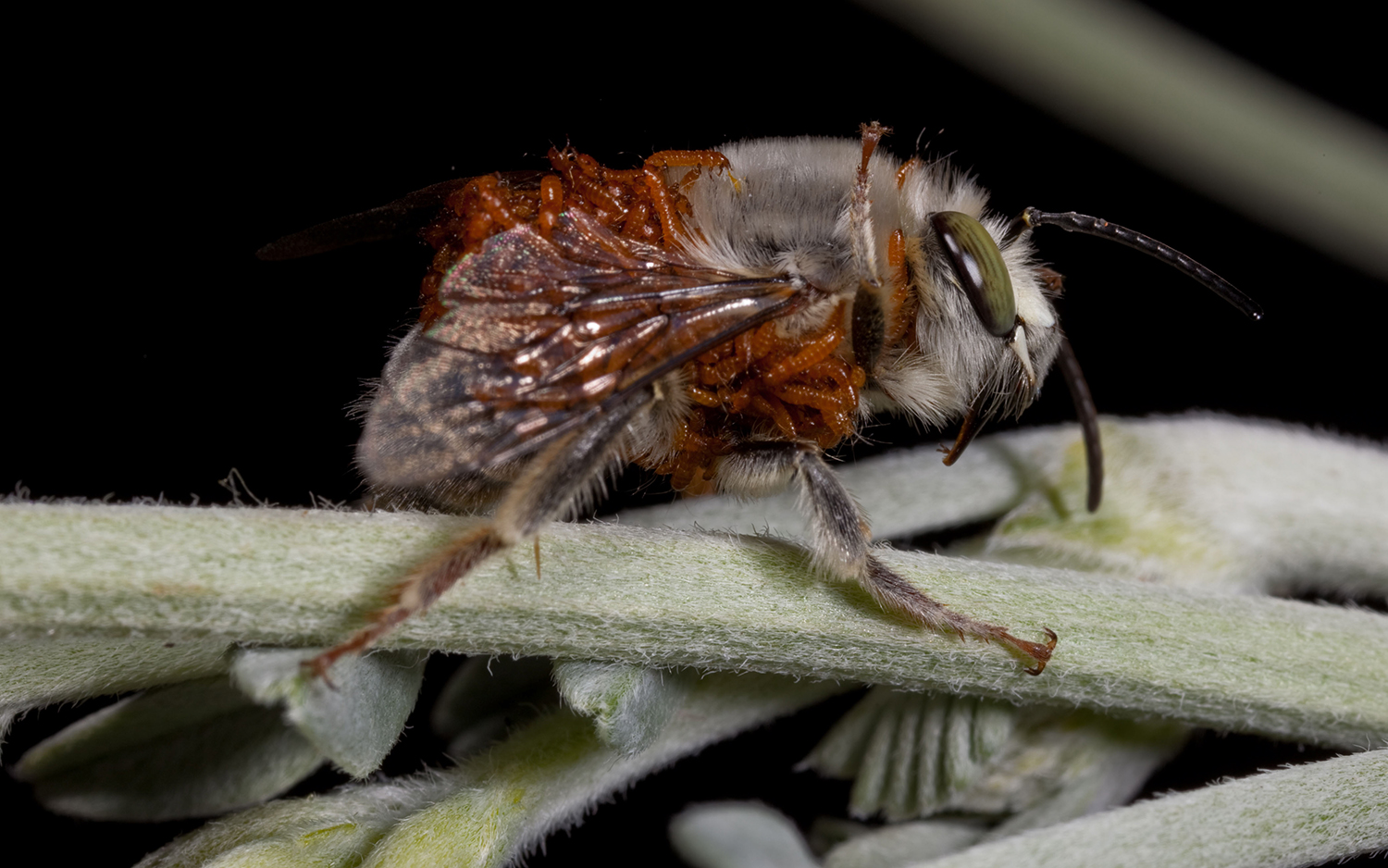Bee That Was Looking for Love Ends Up Wearing a 'Vest' of Parasitic Beetle Larvae

At first glance, this bee appears to be wearing what looks like a shiny brown vest, wrapped around its fuzzy midriff. But closer inspection reveals that the bee is crawling with dozens of wriggling, worm-like brown bodies: larvae belonging to the blister beetle species Meloe franciscanus.
The bee — a male — is the larvaes' first stop in a parasitic hitchhiking strategy that ultimately leads them right into the bees' homes. Once there, these uninvited guests eat the bees' stores of food. And the bees' young.
Known as triungulins, the beetle larvae attract male bees with a chemical signal that mimics the sex pheromones emitted by female bees. To ensure their success, populations of these parasites fine-tune their chemistry and behavior to appeal to different types of bees, depending on where the beetles live and which types of bees are closest to them, according to a new study. [8 Awful Parasite Infections That Will Make Your Skin Crawl]
When a blister beetle larva hatches, it has a lot of company. Hundreds of larvae emerge at once from an egg mass known as an aggregation, which contains about 761 eggs on average, the study authors reported. Scores of larvae siblings then climb nearby plants and huddle together in a single cluster for as long as two weeks, collectively sending a chemical come-hither message wafting through the air.
"And the instant that a male bee contacts an aggregation, the entire larval mass attaches to the male," the scientists wrote.
Triungulins' parasitic attachment to the male is temporary; the larvae hang out on their host's back only until he finds a mate. Then, the hitchhikers transfer to the female bee for a free ride back to the nest, where they gorge themselves on the bees' eggs, nectar and pollen, emerging only in the spring after they're fully grown.
The parasitic larvae were known to infest two species of ground-dwelling digger bees in Oregon and in California's Mojave Desert. Scientists compared different populations of the beetle larvae in those areas to better understand how the parasites interacted with the host bee species: Habropoda pallida and H. miserabilis.
Get the world’s most fascinating discoveries delivered straight to your inbox.
They found that the larvae had evolved adaptations to make themselves as tempting as possible to the bees that lived nearby. In experiments that transplanted groups of blister beetle larvae and exposed them to distant populations of digger bees, the larvae's sexy scents were less successful. In fact, the researchers discovered that the parasites were "significantly more attractive" to the male bees that were their close neighbors.
The scientists also observed that the clusters of newly hatched triungulins climbed to different heights on plants to project their sexy signal, depending on where local bees tended to look for female company.
A 'fantastic' puzzle
Blister beetle larvae aren't the only ones that rely on pheromones to trick and attract other species; bolas spiders also deploy a scent that mimics sexy-smelling female pheromones — a gambit that successfully lures male moths to their doom, the researchers reported.
And the digger bees should probably consider themselves lucky that these larvae only use them as a taxi service. Other parasitic insects turn hosts into living incubators for their growing young — a gruesome fate that culminates in the host becoming the larvae's first meal, as they consume it from the inside out.
Piecing together the strategies used by the parasitic beetle larvae offers new clues about how parasites adapt to best take advantage of their unsuspecting hosts, lead study author Leslie Saul-Gershenz, a doctoral candidate with the Department of Entomology and Nematology at the University of California, Davis, said in a statement.
"It has been fantastic to unravel this species' puzzle," Saul-Gershenz said.
The findings were published online Sept. 10 in the journal Proceedings of the National Academy of Sciences.
Original article on Live Science.

Mindy Weisberger is a science journalist and author of "Rise of the Zombie Bugs: The Surprising Science of Parasitic Mind-Control" (Hopkins Press). She formerly edited for Scholastic and was a channel editor and senior writer for Live Science. She has reported on general science, covering climate change, paleontology, biology and space. Mindy studied film at Columbia University; prior to LS, she produced, wrote and directed media for the American Museum of Natural History in NYC. Her videos about dinosaurs, astrophysics, biodiversity and evolution appear in museums and science centers worldwide, earning awards such as the CINE Golden Eagle and the Communicator Award of Excellence. Her writing has also appeared in Scientific American, The Washington Post, How It Works Magazine and CNN.


